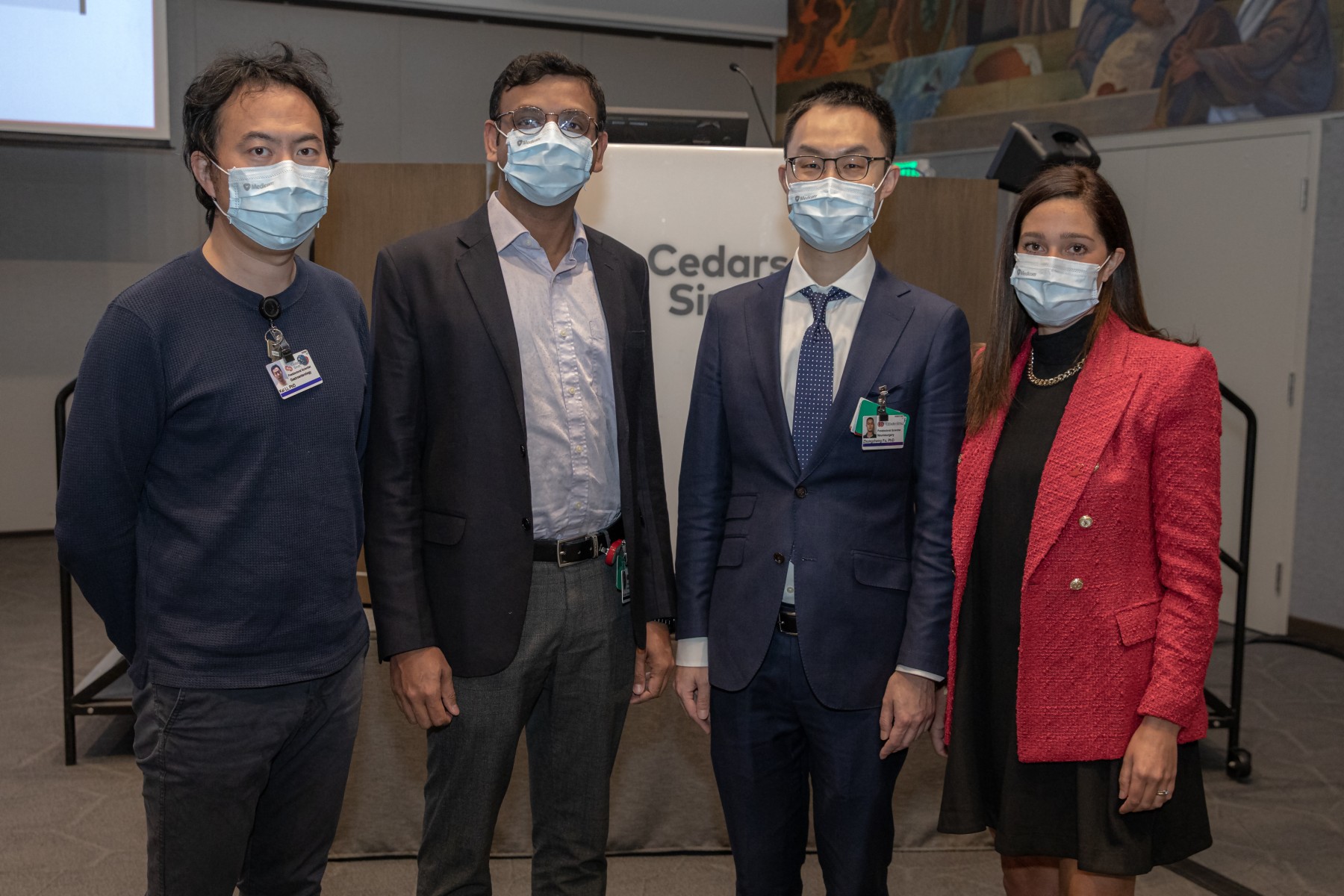Postdocs Studying Heart Repair, Brain Processing Win 2023 Malaniak Awards
Alessandra Ciullo, PhD, who is investigating how certain molecules repair the heart after a heart attack, and Zhongzheng Fu, PhD, whose work helps explain how people learn from mistakes, are the recipients of this year’s Cedars-Sinai Bohdan (Danny) Malaniak Awards for Excellence in Postdoctoral Research.
Every year, two postdoctoral scholars are selected to receive the honors and a $3,000 prize. The award is named after Danny Malaniak, who served as associate vice president for Academic Affairs at Cedars-Sinai and later as a consultant for Cedars-Sinai until his death in 2013.
“The purpose of this award is to foster basic and translational research, enrich knowledge and encourage the development of postdoctoral careers,” said Odelia Cooper, MD, chair of the Malaniak Award Committee and professor of Medicine at Cedars-Sinai, at the abstract presentation, which was held on Feb. 7 at Harvey Morse Auditorium on the Cedars-Sinai Medical Center campus.
Four finalists were selected from applicants representing disciplines across Cedars-Sinai to present their work at the event. A panel of judges assessed the presentations based on study design, methodology, significance, innovation and overall quality of oral presentation.
Repairing the Heart
Ciullo is studying small RNAs, called Piwi-interacting RNAs (piRNAs), which have the ability to switch certain genes on and off. Her focus is on understanding how a type of piRNA called piREX1 reprogram inflammatory immune cells to enable them to repair damaged heart tissue.
Ciullo is a postdoctoral scientist in the laboratory of Eduardo Marbán, MD, PhD, professor of Cardiology and Biomedical Sciences and the Mark Siegel Family Foundation Distinguished Chair and Executive Director of the Smidt Heart Institute at Cedars-Sinai.
Therapeutic cells known as cardiosphere-derived stem cells have been studied in several clinical trials for various diseases. Recent findings suggest these cells release molecules that reprogram injured tissue, which begins the healing process.
“By understanding how individual molecules released by these therapeutic cells repair tissue, we not only know more about how the cells work, but we can also develop these molecules as standalone therapies,” Ciullo said.
Ciullo observed that laboratory rats given piREX1 had much less damage to their hearts after a heart attack than those that weren’t given the treatment. The results are particularly promising considering the treatment was given 20 minutes after the heart attack, Ciullo said.
Understanding How the Brain Learns
Fu’s presentation described research related to performance monitoring, a cognitive process that allows people to learn from their mistakes. The findings were published in May in the peer-reviewed journal Science.
Fu is a postdoctoral scholar in the laboratory of Ueli Rutishauser, PhD, professor of Neurosurgery, Neurology and Biomedical Sciences, director of the Center for Neural Science and Medicine; and the Board of Governors Chair in Neurosciences at Cedars-Sinai.
To conduct their study, Fu, Rutishauser and colleagues observed brain activity in people with epilepsy who had electrodes implanted in their brains as part of their seizure treatment. This allowed the investigators to visualize the activity of neurons located in the brain’s medial frontal cortex, the region thought to be used during performance monitoring.
By observing study participants engaging in specific tasks, the investigators learned that people use the same group of neurons during many activities that require the brain to suppress distractions and to learn from mistakes.
“This monitoring process is critical for learning many important skills and is implicated in mental disorders such as obsessive-compulsive disorder and schizophrenia,” Fu said. “It's critical for us to understand the neural basis better in order to develop treatments for these patients.”
Neuroprosthetic Learning and Fungi Insights
The two other Malaniak Awards finalists were Mohammad Aamir Abbasi, PhD, who gave a presentation titled, “Cortico-cerebellum coordination facilitates neuroprosthetic learning,” and Kai Li, PhD, who presented “Analysis of phagosome diversity reveals PD-L1 as a pattern recognition receptor for fungi.”
Abbasi is a postdoctoral fellow in the laboratory of Tanuj Gulati, PhD, assistant professor of Biomedical Sciences and Neurology at Cedars-Sinai.
Li is a postdoctoral scientist in the laboratory of David Underhill, PhD, chair of the Department of Biomedical Sciences, professor of Biomedical Sciences and Medicine, and the Janis and William Wetsman Family Chair in Inflammatory Bowel Disease at Cedars-Sinai.
The Malaniak Awards are supported by the Burns and Allen Research Institute at Cedars-Sinai in partnership with the Clinical and Translational Science Institute, a National Institutes of Health-funded partnership between Cedars-Sinai, Charles Drew University of Medicine and Science, the Lundquist Institute at Harbor-UCLA Medical Center, and the David Geffen School of Medicine at UCLA.
Follow Cedars-Sinai Academic Medicine on Twitter for more on the latest basic science and clinical research from Cedars-Sinai.




